#Horus of Buto
Explore tagged Tumblr posts
Text
A statuette of Horus of Buto -- an enthroned man with a lion's head, wearing only a kilt and the elaborate hemhem crown.
When: Late Period
Where: Egyptian Museum, Barcelona
39 notes
·
View notes
Text
Dua Wadjet, Wep Tawy 🙏
Praise Wadjet, the one who delimits the Lands
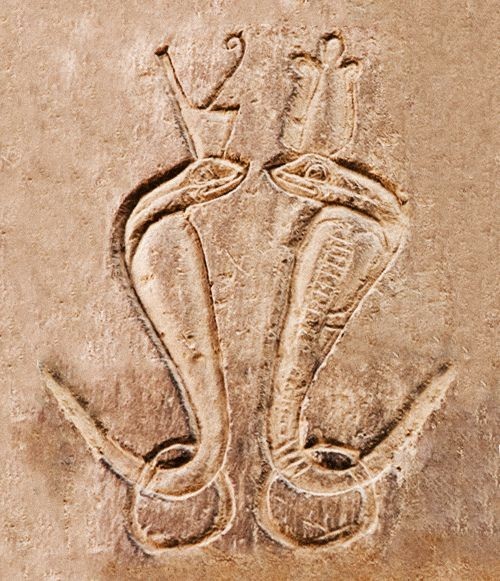



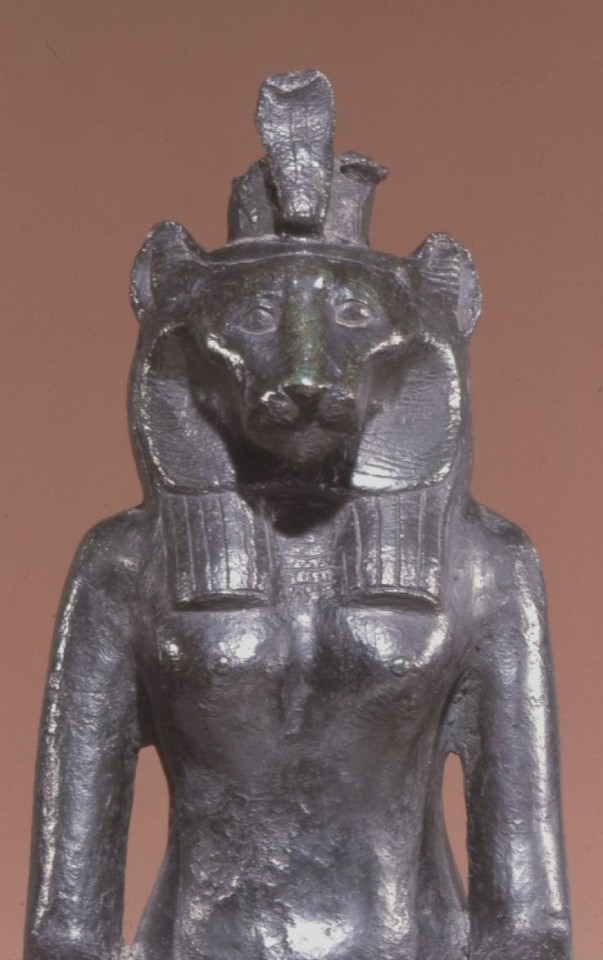

Praise thee, Great of Magic
Praise the Protector of Horus
Praise the Noble Serpent who flowed forth from the Eye
#wadjet#wedjat#buto#udjo#uadjet#eye of ra#eye of horus#dua netjer#dua#netjeru#netjer#kemetic paganism#ancient kemet#kemeticism#kemetic#kemet#kemetic polytheism#egyptian pantheon#egyptian#egyptian gods#ancient egypt#egyptian mythology#egyptian polytheism#egyptian paganism#deity worship#snake god#snake goddess
80 notes
·
View notes
Text
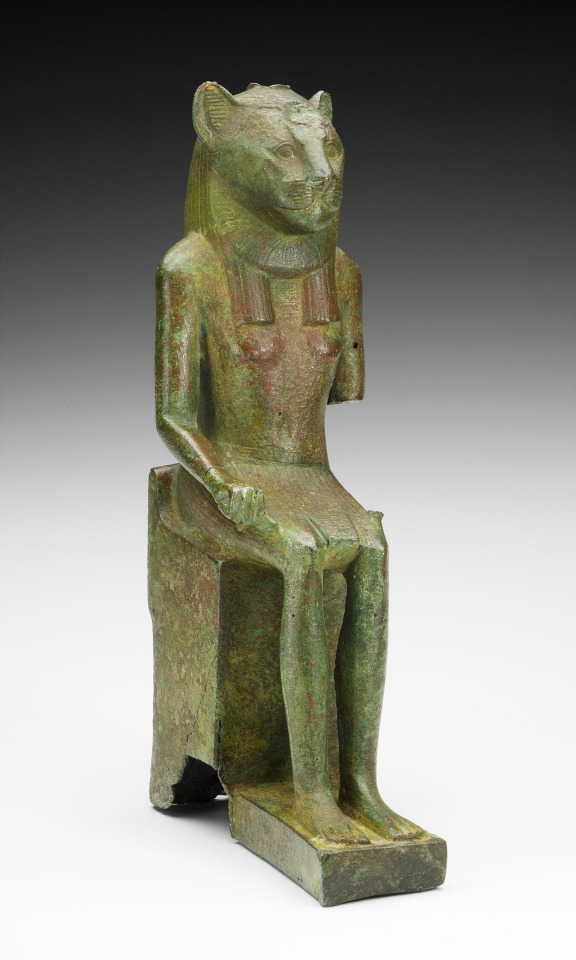
Statuette of a Lion-headed God, probably Horus of Buto
Egyptian, Late Period (664–332 BCE)
Egyptian gods were commonly depicted with human bodies and animal heads. The animal referred to the god’s personality or characteristics, not his or her appearance. For example, this version of Horus, in the guise of the son of the goddess Wedjat, is shown with a lion head, expressive of power. The Greeks and Romans took these mixed forms literally rather than symbolically, and some Classical authors, accustomed to gods in human form, derided the Egyptians for their “ridiculous” gods, dismissing them as “dog-faced Egyptians, dressed up in linen.” Statuettes like these were offered to the gods to ask for their help or in thanks for their assistance.
79 notes
·
View notes
Text

Souls of Pe and Nekhen
These figures of the souls of Pe and Nekhen are identified as King Amenhotep III. The soul of Nekhen is represented by the jackal-headed figure. Its counterpart was the falcon-headed souls of Pe Dep (the double mounds of Buto), which was located in the northern part of the Egyptian Delta. The Souls of Pe and Nekhen, mentioned first in the Pyramid Texts, refer to the ancestors of the ancient Egyptian kings. Grey granite, from Karnak. Nekhen (Greek Hierakonpolis) was the Upper Egyptian center of the worship of the god Horus, whose successors the Egyptian kings were thought to be. New Kingdom, 18th Dynasty, reign of Amenhotep III, ca. 1391-1353 BC. Now in the Egyptian Museum, Cairo. JE 41210, JE 41211
Read more
52 notes
·
View notes
Text
WADJET // EGYPTIAN GODDESS OF THE CITY OF DEP
“She was originally the ancient Egyptian local goddess of the city of Dep or Buto in Lower Egypt, which was an important site in prehistoric Egypt. Wadjet's worship originally started in the Predynastic period, but evolved over time from a local goddess to a patron goddess. Wadjet was closely associated in ancient Egyptian religion with the Eye of Ra and the Eye of Horus symbols, each powerful protective deities.”


5 notes
·
View notes
Text
Egypt's First Observatory Discovered
Star Struck
Archeologists recently uncovered what is believed to be ancient Egypt’s first known astronomical observatory, which they hailed as the “first and largest” of its kind.
Discovered in the ancient city of Buto, in the northern Kafr El-Sheikh governorate, the site dates back to the sixth century BCE and was initially mistaken for a temple because of its peculiar layout.
It had an L-shaped structure with a traditional east-facing pylon entrance that measured more than 9,100 square feet.
But the presence of key artifacts – most notably a large sundial – confirmed the site’s true purpose as an observatory.
“Everything we found shattered our expectations,” said Hossam Ghonim, head of the Egyptian archeological mission, in an interview with Live Science.
Ghonim and his team explained that the ancient building faced east and was aligned with the sunrise where a sky observer, known as a “smn pe,” would have stood to monitor celestial movements.
They added that the observatory has a carving of the “smn pe” facing the rising Sun, which symbolizes the ancient civilization’s close relationship with the cosmos.
But what stood out was a slanted stone sundial, which used the Sun’s shadows to track time, from sunrise to sunset. The researchers also found a “merkhet,” a timekeeping tool the Egyptians used to organize their solar calendar and schedule religious and agricultural events.
The findings provide some insights into how Egyptians used astronomy to determine the solar calendar, religious ceremonies, and the agricultural year. Statues of gods found around the observatory, such as Horus and Wadjet – the latter being a serpent goddess protective of the king – emphasized the spiritual and scientific roles of the site.
Perhaps most intriguing was the discovery of a stone mat inscribed with astronomical depictions of sunrise and sunset across three seasons.
“The ancient Egyptians envisioned the Earth and sky as two mats,” Ghonim said. “They mapped the sky on the ‘Themet Hrt’ – the sky mat – and the ‘Themet Ghrt,’ or Earth mat, represented their calendar, marking events like the Nile flood and harvest. This is the first inscribed stone mat of its kind ever discovered.”
Mohamed Ismail Khaled, secretary-general of Egypt’s Supreme Council of Antiquities, called the observatory a testament to ancient Egypt’s “prowess and skill in astronomy,” Artnet added.
The discovery further attests to humanity’s fascination and quest to learn more about the cosmos, even in the early days.
0 notes
Link
Check out this listing I just added to my Poshmark closet: Charming Egyptian Enamel Horus Pendant Necklace.
0 notes
Text
The ancient Egyptians and their Past (III: Herodotus’ narrative on Psammetichus I and the Eternal Return)
Excerpts from the paper of Roberto B. Gozzoli “History and Stories in Ancient Egypt. Theoretical Issues and the Myth of the Eternal Return” in Martin Fitzenreiter, Das Ereignis. Geschichtsschreibung zwischen Vorfall und Befund. IBAES 10. London: Golden House Publications, 2009. Pr. Gozolli’s contribution to this volume is available on https://www.academia.edu/357223/History_and_Stories_in_Ancient_Egypt_Theoretical_Issues_and_the_Myth_of_the_Eternal_Return
“Psammetichus I and the eternal return
Having introduced a theory, I will now apply it to Psammetichus I and his legend. Psammetichus I was the founder of the Twenty-sixth Dynasty, and the stela of Nitocris, set up at Karnak was issued at the time of Psammetichus I’s established control over Upper Egypt (Caminos 1964; Manuelian 1994, 297-321; Perdu 2002, 17-26; Gozzoli, 2006, 87-92).
Among external sources, Herodotus in particular is the one giving significant information. As Herodotus is introduced to the Labyrinth, the twelve rooms are explained through the story of the Dodecarchy, a partition of Egypt between twelve indigenous rulers (II, 147-149).
Moreover, Herodotus’ informers told him the oracle, which said that the one drinking from a bronze cup in the Ephestus temple will be fated to be sole king of Egypt. The story is completely aetiological and derivative from the etymology of the name Psammetichus “the one of the mtk -cup” or “the one of the mixed wine”, cf. Quaegebeur (1990, 259). Forgetting for the moment about the etymological connection, in the way Herodotus puts the account relative to Psammetichus, the fact that the soon-to-be-ruler drinks from his helmet is considered as an inappropriate - but fully out of malice - error, which an unforgettable prince Psammetichus has done.
Having fully considered the accidental nature of his actions, the other Dodecarchs rightly decided to avoid the death penalty, which was the punishment of such an action, and more humanly sensible, issued that Psammetichus should be secluded in the marshes. Psammetichus’ exile however is the beginnings of the Dodecarchs’ demise, as Herodotus’ informers took pain to note. Buto’s oracle announced the coming of men of bronze (152, 3), who by chance were the Greek mercenaries who made the Saite army for the whole dynasty.
The episode lets Herodotus and his informers say that Psammetichus had already left Egypt once before (II 152, 1), in occasion of Sabaco’s rule over Egypt, as the Ethiopian Sabaco (read Tantamani) had killed his father Necho.16
The specific episode in Herodotus finds a historical confirm from Assyrian sources, which mention the Egyptian prince Nabu-Shezibanni as taking refuge in Assyria, once his father Necho (I) fell fighting against the Nubian army led by Tantamani.17 in Herodotus II, 137, the blind Anysis - an unidentified ruler, possible assemblage of various historical pharaohs - took refuge in the marshes in order not to fall into Sabaco’s hands. As the blindness is usually dictated by something the man does against the deity, the reasons of Anysis’ blindness are passed under silence. In this occasion I may just refer to Lloyd’s commentary about it.18 The escape to the marshes was quite a big topic in the Egyptian literature and myth: the Delta and its slow waters were a place where anyone fleeing from established order escaped. Just reminding a major historical event, it was in the Delta Ramesses III fought the Sea Peoples, making of the occasion one of the major events of his reign. From a mythological point of view, Isis gave birth to her son Horus at Chemmis, an unidentified place in the Delta. It is fair to say that for Anysis as well as Psammetichus (Servajean 2001), their escape to the Delta is used by the fifth century BC priests in order to evoke such a mythological connection. Such connection is not accidental, as Herodotus II, 137 remarks that the island used byAnysis for his refuge was later rediscovered by Amyrtaeus at the time of his rebellion against the Persians .
That Herodotus was not able to fully comprehend the mythological connection present in it does not eliminate its presence in any case. In any case, Herodotus brings together two recurring elements of Egyptian literature and history: the two leaders of the unfortunate Egyptian rebellions under the Persians. Both Inaros and Amyrtaeus took refuge in the marshes in order to escape the preponderant Persian armies, and at least for the latter, fighting to his death.19
This sort of unspecified divine punishment parallels both characters, and such feature may be not entirely casual. Anysis returns, Bocchoris seems to disappear forever, but in the Oracle announces the coming of a saviour, which is part of his own dynasty. The main section is quite fragmentary, butcan still be read: “He is the one of the Two (years),who is not ours, (he is) the one of the fifty-five years,who is ours” (II, 5). I believe that Anysis himself is not a historical figure, but he can be considered as a personification of the House of Sais itself, as the family was able to come back and reunite Egypt...”
“As this workshop is about events, the main question might really be where the event actually is.
From a historical point of view, the amount of material relative to Psammetichus as real historical figure and information about his deeds is certainly minimal. Nothing can be really extracted from Herodotus’ sources, apart a generic statement that Psammetichus ruled in contemporary with other Egyptian rulers, and slowly was able to subdue them to a central power, with the annexation of Thebes and the South in the year 8th of his reign, as testified by the Nitocris stela.
Searching for the event, and if I follow an event based approach will dismiss the set of information given here as folklore. As the very same information can be used as giving glimpses of the feelings of the period comprising the last five centuries of the first millennium BC, and beyond, can be said, the amount of information is essentially different.
Psammetichus and the Saite royal family assumed in the collective imagery the importance and relevance of the last indigenous dynasty, the last one able to defeat foreign armies and keep Egypt altogether. The saviour of Egypt was Psammetichus, this is certainly clear. From a political point of view, this is demonstrated from the different texts and names presented.
The texts however present two different perspectives. First of all, the evil in Egypt can come only whether royal evil actions are made, which make the king lose the gods’ favours, and make the king lose his own status.
This appears in Herodotus, for Cambyses’ madness as the major example. And Psammetichus III’s bad temper against his ambassador defines his fate.
And for the later Lamb and Potter, bad times are the cause of the problems, and why the gods leave Egypt. Whether the abandonment theme was just introduced in the later literature may be possible, but such theme surely goes back as far as Herodotus’account, as it can be possibly seen already with Psammetichus III.”

Roberto Bruno Gozzoli, PhD in Ancient History and Archaeology, Institute of Ancient History and Archaeology, The University of Birmingham, England, is Assistant Professor at the Mahidol University
Pr. Gozzoli’s paper is very informative about the ancient Egyptian conceptions and uses of the past of Pharaonic Egypt.
Moreover, Pr. Gozzoli, like other scholars specialized in Late Period Egypt, accepts that Herodotus did a serious investigation in Egypt and had contacts with Egyptian priests, who told him their version of the past of their country. Of course this priestly account is far from flawless as history, especialy concerning the pre-Saite Egypt, as legends, confusions, and ideological and political uses of the past distort seriously in it the historical reality. Despite his admiration of the Egyptians as the people the most informed about the past of their country, Herodotus himself expressed his dissatisfaction with what he had heard from the Egyptian priests as historical record. But of course he did not have the tools, the means and the time necessary to check the priestly version of the Egyptian history against other (above all written) Egyptian sources.
On the other hand, although it is sure that Herodotus’ Greek identity and his personality played an important role in the selection, interpretation, and organization of the information he gathered from his Egyptian sources, his account of the pre-Saite Egypt and of the beginnings of the Saite dynasty is important, because it records views of the Egyptian elites of the fifth century BCE, Persian-dominated Egypt on the past of their country, as Pr. Gozzoli’s paper shows.
1 note
·
View note
Photo
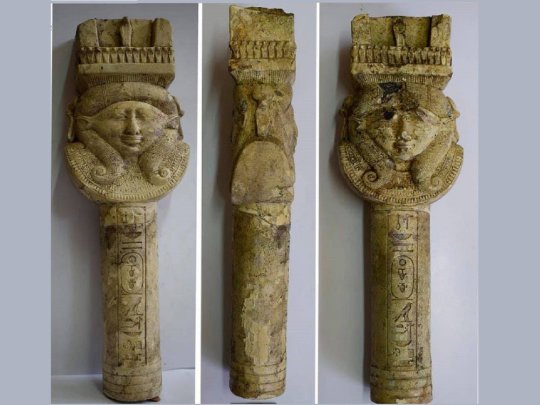
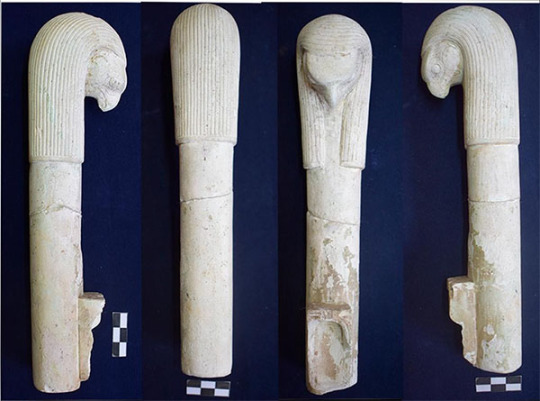


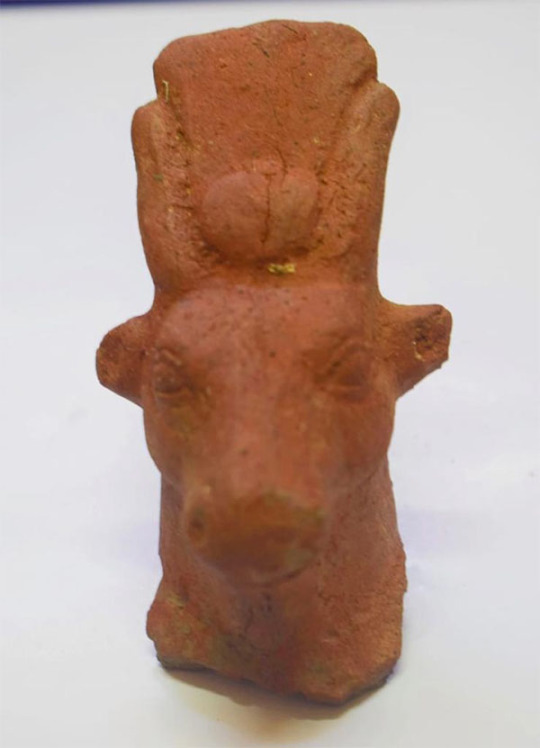
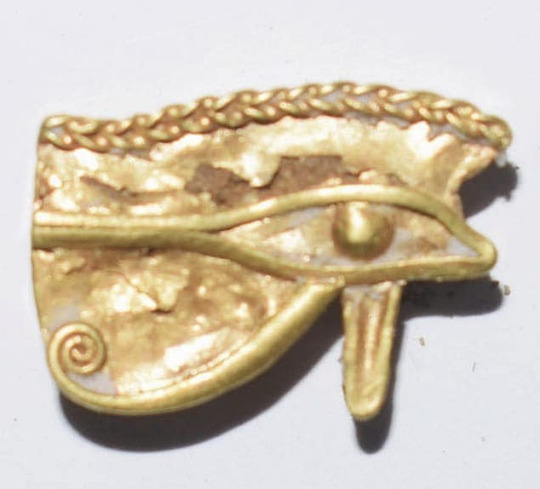
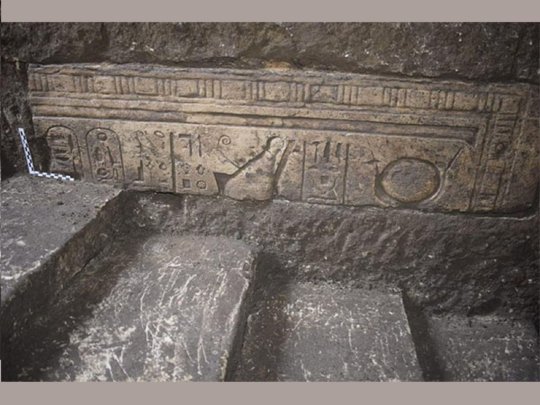

Ancient Egyptian Tools Used in Worship of the Goddess Hathor Discovered
The find also includes works of art, as well as a bath with running water.
Archaeologists have discovered a number of tools that ancient Egyptians used in the ritual worship of the goddess Hathor. The Egyptian Ministry of Tourism and Antiquities found the objects in the ancient city of Buto in Kafr El-Sheikh province, north of Cairo, Angy Essam reports for Egypt Today.
During an excavation of a site known as Tell El Fara'in, or the Hill of the Pharaohs, the team found part of a limestone pillar in the form of Hathor together with a well used for sacred water, an offering holder and the remains of gold scales used for gilding other objects. They also found incense burners made of tin-glazed faience pottery, including one decorated with the falcon head of the god Horus.
“It is one of the important discoveries because it includes the tools that were actually used in performing the daily religious rituals for goddess Hathor,” Mostafa Waziri, head of the ministry's Supreme Council of Antiquities, says in a statement, according to Xinhua News Agency.
The find also included small clay statues of the goddess Taweret, who is associated with childbirth, and several other works of art. Ivory reliefs show scenes from daily life, including women carrying offerings, as well as images of birds, animals and plants. A partially preserved painting depicts a king performing rituals at the temple.
Per Mena’s Kamal Tabikha, the temple complex also held a bathing room with a bathtub, a small basin, and a vessel used for heating water. The bath was equipped with a simple plumbing system for carrying fresh water in and removing waste water.
The researchers also found hieroglyphic inscriptions, Nevine El-Aref reports for Ahram Online. The writing includes the five titles of King Psamtik I, who ruled from 664 to 610 B.C. during the 26th dynasty, as well as the names of two other kings from that dynasty, Waha Ip-Ra and Ahmose II.
Also among the finds is a pure gold eye of Ra, also known as an eye of Horus, or Ujat. Hathor was sometimes said to be Ra’s eye, according to Encyclopedia Britannica. Often taking the form of a cow, Hathor first appeared in the third millennium B.C. Many Egyptian communities had cults of Hathor. In various places and times, she was associated with fertility and love, with beauty, with the land of the dead and even with minerals such as turquoise. Another discovery at the site was a “maternity chair,” appropriate to Hathor’s status as a fertility goddess.
The city of Buto was the capital of Lower Egypt, the northern part of the modern-day nation, before it became unified with Upper Egypt around 3100 B.C. The artifacts found at the Hill of the Pharaohs are much more recent. Previous archaeological work at the site found that objects discovered there dated to between 664 and 332 B.C., as Callum Paton reported for Newsweek in 2018.
By Livia Gershon.
#Ancient Egyptian Tools Used in Worship of the Goddess Hathor Discovered#archeology#history#history news#ancient history#ancient civilizations#ancient egypt#egypt#buto egypt#hill of the pharaohs#pharaohs
8 notes
·
View notes
Photo

Wadjet, also spelled Wadjit, also called Buto, Uto, or Edjo, cobra goddess of ancient Egypt. whose name means "green", lives in the swamps of papyrus and reeds in the Delta, and represents the "daughter of Ra and his eye" Wadjet was nurse to the infant god Horus and helped Isis, his mother, protect him from his treacherous uncle, Seth, when she took refuge in the delta swamps . . . #snake #cobra #waterway #swamp #history #egypt #ancientegypt #goddess #protectivestyles #protection https://www.instagram.com/p/CVGJagDIzhN/?utm_medium=tumblr
3 notes
·
View notes
Text
TR1: Sanctuary of the Scion (1)
It's time to pick up where I got. It's time to finish this level and the game.
12.01 - the sema symbol. As the level progresses Lara sees the second piece of the scion on a block. The block has a symbol in it called Sm3 (Sema) which is to unite the two lands: lower and upper-Egypt. The reed and lotus.
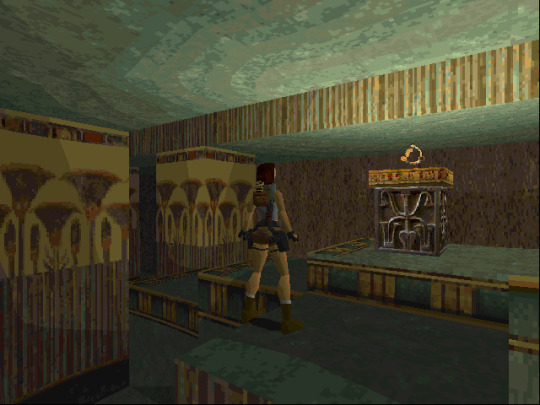
The conquest of Lower Egypt
To the legend of ancient Egypt, the countries were united by Menes the first king of Egypt in the first dynasty. He conquered from Upper the lower Egypt. In historical perspective there were kings in Upper-Egypt buried in Umm el-Qaab that are local kings like king Scorpion I, Bull, Elephant, Hat-Hor, Iry-Hor and others. King Scorpion II from dynasty 0 (before the first dynasty, not to confused with dynasty 00) was the first one that conquered Lower Egypt, then his son (?) King Narmer finished the war between the both Egypts. The symbolism is that every king should remain heavenly order (ma-at) in Egypt and that is to unite or to reunite Egypt and have 1 king on the throne just like king Menes did.
The sema symbol is depicted with Horus and Seth or Buto (snake goddess of the double city of Pe and Deb) or and Nechbet (vulture goddess of the city of nekhen). The symbol can be seen on thrones or on statues.
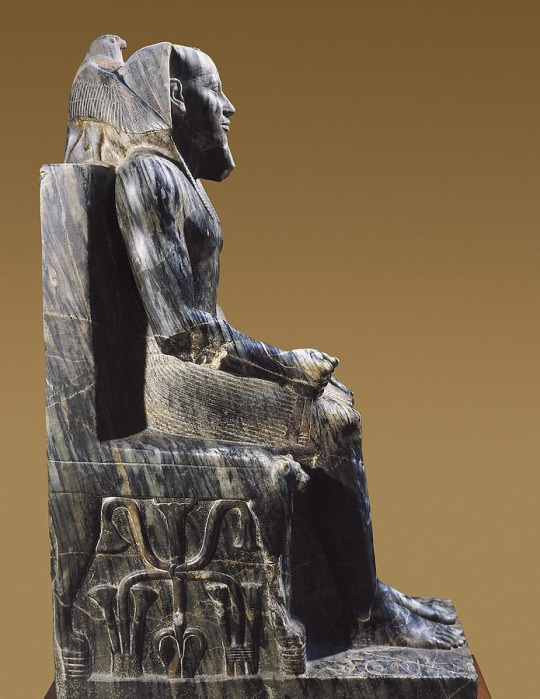
The symbol can be compared with this statue of king Khafre or Chephren according to the Greeks. A king of the 4th dynasty, his pyramid is in Gizeh near Caïro (or Gizeh in Caïro today). This statue has an unique design, the god horus protect the head of the ruler, he is wearing a Nemes-headdress.
Next one will be Natla's mines.
21 notes
·
View notes
Text
Egipto: la historia documentada más larga del mundo

Egipto es la civilización antigua de la que se tienen más registros históricos, lo que la hace la historia más larga del mundo (3,150 A.C. - 31 A.C.)
Pero, aunque no lo crean, no es para nada aburrida (es tan interesante que se terminó por el derrocamiento por parte de las tropas romanas de Octavio, que vencen a Marco Antonio, quien estaba aliado y enamorado de Cleopatra, otra larga historia, quien fue la última en una larga lista de reinados de faraones)
En fin, en este blog conocerás un poco de TOOOODA esa gran historia.

Todo comienza justo aquí, en el Río Nilo, donde se asentaron los primeros habitantes. Este era su secreto: el río era su fuente de prosperidad, por su larga extensión, les permitía realizar grandes trabajos de pesca, cosecha y ganadería.
Estos habitantes eran gobernados por “seres divinos" a los que siguieron dinastías semi heróicas: "los descendientes de Horus". Primeramente se divide en periodo Arcáico y periodo predinástico donde surgen el Reino Alto y el Reino Bajo.
Alto y Bajo Egipto
El Bajo Egipto se situaba en el Norta y estaba formado por 20 nomos, de las cuales las más importantes eran Buto y Sais. Tenía un faraón propio, sus reyes llevaban una corona roja y alargada y su divinidad era la cobra.
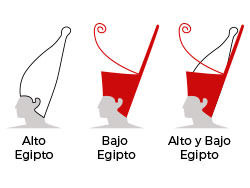
Diferentes coronas de Egipto
El Alto Egipto se situaba al Sur y se componía de 22 nomos, tenía como ciudades principales Hieracómpolis y Nejeb y también con un faraón propio, la corona de sus reyes era blanca y su diosa era un buitre.
“Hacia el 3100 a. C. el rey Menes del Alto Egipto invadió el Bajo Egipto unificando ambos reinos. Menes se convirtió en el primer soberano de la I dinastía y fue calificado como el "unificador de ambos países". Con él se inicia el periodo histórico y la primera de las treinta dinastías que gobernarían Egipto hasta su conquista por el rey persa Artajerjes” https://www.egipto.net/historia
La unión de estos dos reinos se le atirbuye a Menes (Narmer) fundador de las dinastías y primer faraón conocido históricamente.
La historia de las dinastías egipcias, según los historiadores, se ha dividido en tres grandes periodos: Imperio Antiguo, Imperio Medio e Imperio Nuevo.
Imperio Antiguo ( 2635 a. C)
Se establece en Menfis y es gobernada por el faraón Zoser (III dinastía). En esta época se comienzan a erigir pirámides y monumentales de piedra. La primer pirámide conocida es la de Zoser, más adelante, en la IV dinastía, se construyen las pirámides quizás más conocidas y famosas de la actualidad: Keops, Kefrén y Micerinos.

Son la única maravilla del mundo antiguo que se conserva hasta la actualidad
Imperio Medio (2050 a.C)
Luego de una época de decadencia, el faraón Mentuhotep II, unifica de nuevo los dos reinado de Egipto y comienza el Imperio Medio. La capital se traslada a Tebas y es un periodo de gran prosperidad y expansión. En esta época se impusieron rituales y cultos a diferentes dioses.

Dios Amon, de la creación.
Imperio Nuevo (1550 a.C)
Luego se haber sido invadidos por los hicsos, los egipcios adoptan armas, caballería y carruajes y derivados del bronce, dándole inicio al Imperio Nuevo. Este se caracteriza por mucha violencia y guerras, primero desponjando a los hicsos y luego expandiéndose.
Este es el periodo de monumentalidad y arquitectura egipcia en su máximo esplendor.
Igualmente, gracias al faraón Akenaton y a su esposa Nefertiti, los sistemas políticos y religios se ven afectados, desponjando a los sacerdotes de sus cargos importantes y dando paso a una religión monoteísta, suprimiendo el culto a muchas deídades. Luego, Tutankamon reestablece todo lo que su padre derrocó, este es de hecho uno de los faraones más conocidos.

Tumba de Tutankamon, uno de los mayores hallazgos de la historia, conservada hasta la actualidad.
La tumbas eran destinadas a los faraones y dentro de ellas se encontraban pasadizos, rodeados por muros donde se plasmaban sus creencias y estilos de vida. Se creía que estos permanecían allí de manera que preservaran siempre sus comodidades y se recordarían hasta la eternidad, ya que iban a ascender al cielo en forma de estrellas
Con la llegada de Ramses II se edifican grandes templos dedicados a los diferentes dioses egipcios, estos eran caracterizados por proporción y su geometría

Templo de Abu Simbel, si ven la escala, en serio eran enormen, todos parecen hormigas.
MOBILIARIO EN EL ANTIGUO EGIPTO
Este es el tema realmente importante y a destacar dentro del blog. Como ya sabemos los egipcios creían en la vida después de la muerte y praticaban momificación, para lo cual, elbasamaban los cuerpos para preservarlos a través del tiempo, y acompañaban a sus muertos con sus pertenencias más atesoradas, estas en ocasiones eran en efecto: MOBILIARIO
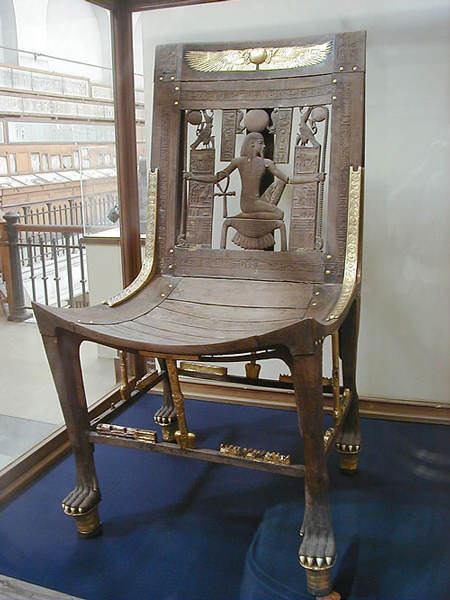
Silla encontrada en tumba de Tutankamon, descubierta en 1925 por Howard Carter
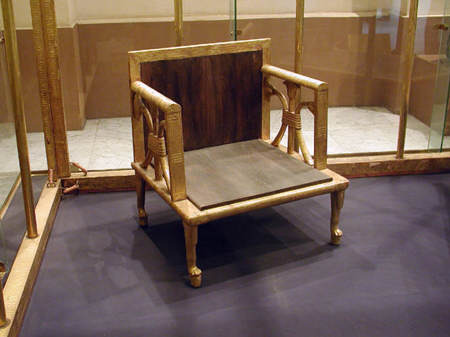
Silla encontrada en la tumba de Hetepheres, uno de los muebles más antiguos que se conocen, poseía filigrana ornamental tallada en madera, descubierta en 1925 por el antropólogo George Andrew Reisner
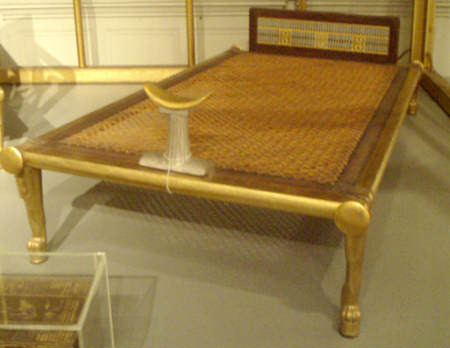
Cama de Hetepheres, con reposadero para cabeza, de madera revestida de oro, descubierta en 1925 por el antropólogo George Andrew Reisner
Ornamentación
La deidades eran representadas con cuerpo humano y cabezas de animales, elementos que retomaban de cierta manera en la elaboración de sus mobiliarios. Utilizaban alas de pájaron, cabezas de león o patas de pato. Tenían una fuerte fascinación por los felinos (michis-lover)
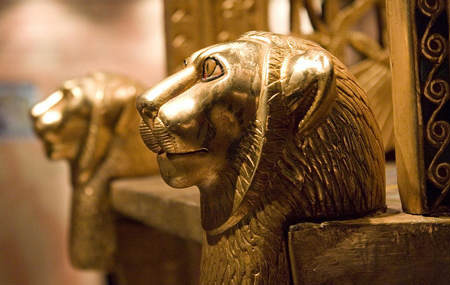
Trono de Tutankamón, detalle de cabezas de león bañadas en oro.
Su sistema de escritura eran los jeroglíficos, inventada desde la era arcaica. En ella se utilizaban íconos que tiene muchas representaciones, ideogramas y fonogramas. Pintaban o esculpían piezas de la arquitectura civil o religiosa sobre los muebles.
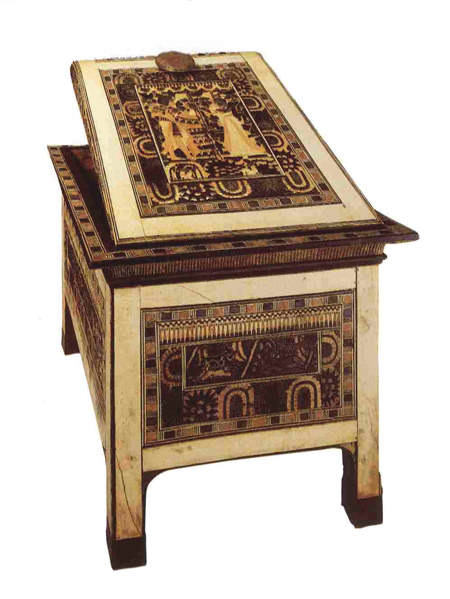
Arcón de marfil, tumba de Tutankamón
Materiales
El material por excelencia era la madera, en el Antiguo Egipto este material era abundante y común en las orillas del Nilo. Para la realeza se importaban maderas de cedro, pino y ébano.
Creían en muchos dioses, dependiendo de la ciudad en la que estaban, por ello, se construían cientos de templos dedicados a todos estos. Para ellos, la religión influía en todos los aspectos de su vida, por lo que la elección de materiales estaba arraigada a esta visión religiosa.
El oro se asociaba con Ra, dios del Sol y se representaba como símbolo de vida eterna. La planta se asociaba con la Luna. Recubrían los mobiliarios de los faraones, mayormente, de baños de oro (No imagino lo top que se sentían)

Tipos de Mobiliario
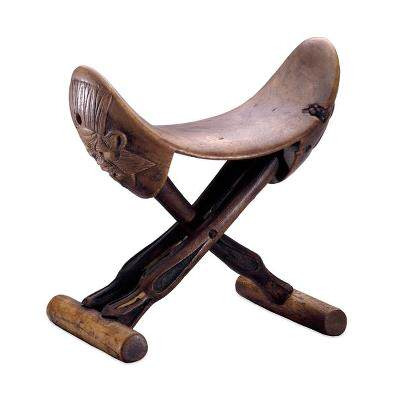
Los reposacabezas también conocidos como uol, solían ser de madera o barro. Se utilizaban para preservar el peinado del usuario, a ello se debe su altura y su dureza, aunque en ocasiones se forraba de lino para suavizar.
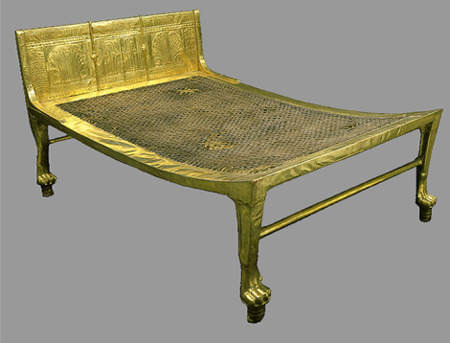
Camas. Habían de diferentes tipos, La típica denominada angarib, presentaba un entretejido muy sencillo de correas vegetales sobre los que se ponía una especie de colchón. También tenían los denominados “lechos de reposo” o divanes, eran más cortas y bajas que las típicas y había más presencia de las figuras animales.
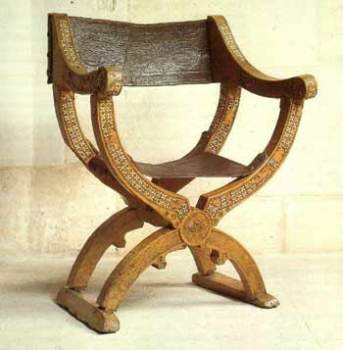
Sillas. Existían de diferentes formas, estaban las sillas de tijera, sillas rectangulares, con respaldos y brazos, entre otras. Esta ultima era la más elaborada, llena de adornos y filigrana y se encontraba únicamente en los palacios; mientras que las primeras, presentaban ornamentación con elementos de motivos de animales y tenían un asiento concavo.
Muchos de estos mobiliarios se ven representados en distintas películas que han surgido a través del tiempo que se sitúan en aquella época y tratan de recrear estos ambientes.

La cultura Egipcia fue sumamente rica en muchos aspectos, dándole la importancia que permanece hasta en la actualidad. Si quieres saber más acerca de su riqueza cultural, puedes ver el siguiente vídeo que resume la extensa historia de Egipto Antiguo. Igualmente si quieres conocer más de los personajes que más marcaron la historia de Egipto puedes ver estos vídeos.
youtube
youtube
youtube
4 notes
·
View notes
Text
Creation of the Egyptian state
One of the most rapidly emerging early states appeared along the Nile River during the Early Dynastic period of ancient Egypt. The standard theories cite gradual population growth leading to land shortages, warfare, and domination by the strongest chiefdom; or need for extensive irrigation to control flooding, but as Dmitri Proussakov points out, settlement patterns were actually irregular and population was low in Upper Egypt at the time of politogenesis, and there is no evidence that a general irrigation system existed at that time (drainage, in fact, appears to be the main infrastructural activity encouraged by the early state). All the supposed preconditions for state formation are lacking: a shortage of resources; an external military threat; or the influence of other states. [200]
The Nile Valley was populated by numerous independent chiefdoms that alternated between war and trade. Before the reign of King Narmer, one of those chiefs, there was little to suggest that any of them was on the point of erecting a state. The chiefdom centered at This—the home of the pharaohs who would eventually unify the Nile under one state—dominated Upper Egypt, but even there their authority was more reciprocal or status-driven than state-like. They did, however, excel in the use of large boats to transport collective work crews, soldiers, cargo, and the pharaoh himself in expeditions of a ritual, commercial, or military nature.
Around 3100 BCE, possible flooding and a rise in sea level seems to have sent a wave of ecological refugees out of the Nile Delta and into to Upper Egypt, Canaan, and other neighboring lands. Something on the scale of 120,000 people, with all their livestock arrived, in Upper Egypt, which was dominated by the Thinite pharaohs. Symbolically defeated and subordinated by King Narmer, they were “naturalized” and allowed to settle, providing a basis for state power.
Subjugation of such a multitude of people could not fail to result in unprecedented growth of [the] personal authority of Thinite rulers and to raise the military-economic potential of the “Thinite Kingdom”. For instance, the ‘captives’ might have been recruited to build Memphis, the future capital of Egypt, under Narmer’s successor Horus Aha [..] Archaeological excavations reveal the Memphis region to be rather densely populated at the earliest Dynastic times. [201]
But in a powerful showing of reciprocity, the totem of the Delta people, the hawk, was elevated to become the chief deity of the emerging state; Horus replaced Seth, the traditional god of Upper Egypt, in preeminence. [202] Such reciprocity is a sure sign that state authority had not yet been established and that Narmer, at least at the beginning of his reign, was the head of a chiefdom and not a state.
The organization and administration of such a large population, dislocated at least in part from its traditional community structures, would have provided a unique opportunity for bureaucratic innovation, also liberating the king from his chiefly role as the head of a single kinship group, and the representative of a single localized deity. We can assume that the refugees were not transformed into a permanent subordinate caste, as the Aryans did with the conquered Dasas, since it was presumably the Delta people who returned to (re)build Memphis—now under the authority of the This pharaohs—during the reign of the very next ruler. This likelihood seems to confirm that the capture of the 120,000 was a primarily symbolic victory and not a full military humiliation that might have wreaked the psychological consequences necessary for creating a new underclass.
As the Egyptian polity grew and took on the features of a state, it did not spread as a cohesive territorial unit but as a network of discrete enclaves amidst weaker but independent chiefdoms. The capitals of the emerging Egyptian state, This and Memphis, were sites for the worship of deceased pharaohs, whereas the other enclaves, such as Hierakonpolis, Elkab, Koptos, Buto, and Sais, were each dedicated to a specific god or goddess. It was the River Nile that connected them all, allowing a rudimentary state to govern dispersed settlements separated by hundreds of kilometers and surrounded by neutral or hostile chiefdoms. [203]
Boats and ritual activities on the river had long been important to Egyptian tribal elites, and the use of large cargo or troop boats powered by many rowers allowed “selective colonization of the Nile banks, sailing safely to occupied territories” and “avoiding destructive overland battles.” The pharaoh, representing Horus, sailed the Nile twice a year in an important ceremonial procession, ensuring the administrative unity of the state and also reenacting a creation myth in which the divine ruler traveled the world with his possessions and “thus established the world order.” [204] Boats were even buried next to kings in their sacred tombs.
The Egyptian proto-state took advantage of its symbolic monopoly of the river (or at least a privileged access to the river that no chiefdom was powerful enough to obstruct) in order to monopolize trade between the enclaves, which in addition to displaying religious specialization also produced different material goods. By the time of Horus Den in the First Dynasty, the state owned numerous granaries and other storage facilities that conceded an advantage in trade and extra power when climatic changes or Nile flooding provoked scarcity. Simultaneous to this expansion, the number of administrative officials increased.
Commerce along the river in the form of ceremonial gift-giving played an important role in the spiritual expansion and political unification of the early Egyptian state. The This kings made lavish gifts and built temples honoring local deities in then-unconquered Middle Egypt or other autonomous stretches of the river. Similar to the expansion strategy of the Inca state and various Buddhist states of Southeast Asia, early Egypt did not rely exclusively on military conquest but sought religious alliances. In the temples, state gods were symbolically unified with local deities, rendering a sign of respect to the unconquered culture and also clearing the path for its integration. Granted, such gift-giving rituals are not typical of state authority, which is based on the command relationship; however, they do constitute a strategy for eventual incorporation. They also decrease hostilities that could interfere with the cohesiveness of the enclaves. Lesser chiefdoms that accepted the gifts were recognizing the Egyptian state as the uncontested power on the Nile. However, since the Thinite pharaohs had to give more valuable gifts than they received in order to preserve their supreme status, the semi-autonomous chiefs rose in status upon receipt of the gifts, especially relative to their own populations. In time, their accumulation of power allowed them to challenge the enclave state. [205] However, the symbolic power of the state was the motor of this crisis; though they were able to challenge state dominance, the other chiefdoms were also becoming more statelike. Pharaonic gift-giving was a cratoforming exercise that broke the power of the first state and laid the groundwork for the emergence of a larger and more unified state.
In the time of the early Second Dynasty, there was a political crisis that saw the fragmentation of the enclave-based state, with the result that the pharaohs, relocated in the larger city of Memphis, were cut off from their ancestral home at This. When the Egyptian state regained its force, it unified the whole of the Nile in one territorial body backed by the non-reciprocal force of military conquest, ending the enclave system and also the reliance on a spiritual, trade, and gift-giving network that followed the course of the river. Religious power remained central, as seen in the growth of the cult of the sun god Ra and the frenetic construction of pyramids to honor the divine pharaohs.
The Egyptian example is distinct from primary state formation in the Andes and Sumer. The position of a supreme ruler appeared earlier in the evolution of the Egyptian state than in these other examples. There may be elements of the royal court state model of politogenesis, with warfare between hierarchical chiefdoms enabling the emergence of a supreme ruler simultaneous to the establishment of spiritual trade networks; however, an anomaly among states, patriarchy in Egyptian society was remarkably light, with multiple women rulers. Massive monument building also followed rather than preceded state formation. It was not until the Third Dynasty that the first pyramids were built, though the Egyptian, Andean, and Sumerian pyramids make a poor comparison, since the pyramids of the former were not places of spectacular public worship but sites for the adoration and divinity-building of deceased pharaohs. It may be that the Nile itself provided the stage for the sort of spectacular ceremonies that Sumerian and Andean early states performed on their ziggurats and ceremonial platforms.
— Peter Gelderloos “Worshiping Power: An Anarchist View of Early State Formation” chapter XI
14 notes
·
View notes
Photo


Oxyrhynchus Hymn to Isis
This papyrus was written at the start of the second century A.D., but it is believed that the text was composed earlier, probably during the reign of the emperor Augustus. What survives is only about half of the original hymn. The first half emphasizes the syncretism of Isis with other deities, as a result of which she was called Myrionymos, the goddess of ten thousand names.
The translation is adapted from B.P.Grenfell & A.S.Hunt in volume 11 of The Oxyrhynchus papyri (1915), where the Greek text of P.Oxy. 1380 can also be found.
Aphroditopolis One- . . . ; in the House of Hephaestus ..chmeunis ; who at ...ophis are called Bubastis, . . . ; at Letopolis Magna one, . . . ; at Aphroditopolis in the Prosopite nome fleet-commanding, many-shaped, Aphrodite; at Delta giver of favours; at Calamisis gentle; at Carene affectionate; at Niciu immortal, giver; at Hierasus . . . athroichis ; at Momemphis ruler ; at Psochemis bringer to harbour ; at Mylon ruler ; at Ce . . culemis . . . ; at Hermopolis of beautiful form, sacred ; at Naucratis fatherless, joy, saviour, almighty, most great; at Nithine in the Gynaecopolite nome Aphrodite ; at Pephremis Isis, ruler, Hestia, lady of every country ; at Es . . . Hera, divine ; at . . . ; at Buto skilled in calculation, . . . ; at Thonis love . . . ; in the Saite nome victorious, Athena, nymph ; at Nebeo . . . ; at Caene joy ; at Saïs Hera, ruler, perfect ; at Iseum Isis ; at Sebennytus inventiveness, mistress, Hera, holy ; at Hermopolis Aphrodite, queen, holy ; at Diospolis Parva ruler ; at Bubastis of old ; at Heliopolis Aphrodite ; at Athribis Maia, supporter; at Hiera in the Phthemphuthite nome lotus-bearing; at Teouchis sacred, mistress ; among the Bucoli Maia ; at Xois of old, oracular ; at Catabathmus providence; at Apis understanding; at Leuce Acte Aphrodite, Mouchis, Eseremphis; at Phagroriopolis . . . ; at Choatinê victorious ; at . . . skilled in writing, . . . ; at Cynopolis in the Busirite nome Praxidicē; at Busiris fortune, good ; at Hermopolis in the Mendesian nome leader ; at Pharbaethus of beautiful form ; at Isidium in the Sethroite nome saviour of men ; at Heracleopolis in the Sethroite nome mistress ; at Phernouphis ruler of cities ; at Leontopolis serpent, good ; at Tanis of gracious form, Hera ; at Schedia inventiveness ; at Heracleum lady of the sea; at Canopus leader of the muses; at Menouthis truth; at Meniouis seated before Io in whose honour . . . is founded ; at . . enestium most great, vulture-shaped, Aphrodite; at Taposiris Thauestis, Hera, giver; in the Island swiftly victorious ; at Peucestis pilot ; at Melais (?) many-formed ; at Menouphis warlike ; in the Metelite nome Core; at Charax Athena; at Plinthine Hestia; at Pelusium bringer to harbour; in the Casian district Tachnepsis ; at the Outlet Isis, preserver; in Arabia great, goddess ; in the Island giver of victory in the sacred games ; in Lycia Leto ; at Myra in Lycia sage, freedom ; at Cnidus dispeller of attack, discoverer ; at Cyrene Isis ; in Crete Dictynnis ; at Chalcedon Themis; at Rome warlike; in the Cyclades islands of threefold nature, Artemis ; at Patmos young, . . . ; at Paphos hallowed, divine, gentle ; in Chios marching ; at Salamis observer ; in Cyprus all-bounteous ; in Chalcidice holy ; in Pieria youthful; in Asia Worshipped at the three ways ; at Petra saviour ; at Hypsele most great ; at Rhinocolura all-seeing; at Dora friendship ; at Stratonos Pyrgos Hellas, good ; at Ascalon mightiest ; at Sinope many-named ; at Raphia mistress ; at Tripolis supporter; at Gaza abundant ; at Delphi best, fairest ; at Bambyce Atargatis ; among the Thracians and in Delos many-named ; among the Amazons warlike ; among the Indians Maia ; among the Thessalians moon ; among the Persians Latina ; among the Magi Korē, Thapseusis; at Susa Nania ; in Syrophoenicia goddess ; in Samothrace bull-faced ; at Pergamon mistress ; in Pontus immaculate ; in Italy love of the gods ; in Samos sacred ; at the Hellespont mystic ; at Myndus divine ; in Bithynia Helen ; in Tenedos name of the sun ; in Caria Hecate ; in the Troad and at Dindyma . . ., Palentra (?), unapproachable, Isis ; at Berytus Maia ; at Sidon Astarte ; at Ptolemais understanding ; at Susa in the district by the Red Sea Sarkounis ; you who also interpret first of all in the fifteen commandments, ruler of the world ; guardian and guide, lady of the mouths of seas and rivers ; skilled in writing and calculation, understanding ; who also bring back the Nile over every country ; the beautiful animal of all the gods ; the glad face in Lethe ; the leader of the muses ; the many-eyed ; the comely goddess in Olympus ; ornament of the female sex and affectionate ; providing sweetness in assemblies ; the lock of hair (?) in festivals ; the prosperity of observers of lucky days ; Harpocratis of the gods ; all-ruling in the processions of the gods, enmity-hating; true jewel of the wind and diadem of life; by whose command images and animals of all the gods, having . . . of your name, are worshipped ; lady Isis, greatest of the gods, first of names, Io Sothis ; you rule over the mid-air and the immeasurable ; you devise the weaving of . . . ; it is also your will that women in health come to anchor with men ; all the elders at E...ctus sacrifice ; all the maidens who . . . at Heracleopolis turn (?) to you and dedicated the country to you ; you are seen by those who invoke you faithfully ; from whom . . . in virtue of the 365 combined days ; gentle and merciful is the favour of your two ordinances ; you bring the sun from rising unto setting, and all the gods are glad ; at the risings of the stars the people of the country worship you unceasingly and the other sacred animals in the sanctuary of Osiris, they become joyful when they name you ; the . . . spirits become your subjects ; . . . . . . . . . and you bring decay on what you will and to the destroyed bring increase, and you purify all things ; every day you have appointed for joy ; you . . . having discovered all the . . . of wine provided it first in the festivals of the gods . . . ; you became the discoverer of all things wet and dry and cold and hot of which all things are composed ; you brought back alone your brother, piloting him safely and burying him fittingly; . . . . . . leader of diadems ; lady of increase and decay and of . . . . . . . . . you established shrines of Isis in all cities for all time; and delivered to all men observances and a perfect year ; and to all men . . . in every place ; you showed . . . in order that all men might know that you . . . ; you established your son Horus Apollo everywhere the youthful lord of the whole world and . . . for all time ; you made the power of women equal to that of men ; and in the sanctuary you did . . . nations . . . . . . . . . you, lady of the land, bring the flood of rivers . . ., and in Egypt the Nile, in Tripolis the Eleutherus, in India the Ganges ; owing to whom the whole and the . . . exists through all rain, every spring, all dew and snow, and all . . . and land and sea ; you are also the mistress of all things for ever; . . . you made the . . . of the Dioscuri ; . . . you have dominion over winds and thunder and lightning and snow ; you, the lady of war and rule, easily destroy tyrants by trusty counsels ; you made great Osiris immortal, and delivered to every country . . . religious observances ; likewise you made immortal Horus who showed himself a benefactor . . . and good ; you are the lady of light and flames; you . . . a sanctuary at Memphis; Horus having judged beforehand that you had appointed him successor of his father . . . enthroning him, . . . . . . . . . you established him lord of the throne and oracular king over his father's house for all time ; in your honour out of three temples that at Busiris called . . .
4 notes
·
View notes
Link
Check out this listing I just added to my Poshmark closet: Charming Egyptian Enamel Horus Pendant Necklace.
0 notes
Photo

Temple of the God Horus at Behdet (Edfu), detail from the scenes related to the Feast of "Opening the Year of the Reign of Horus" represented on the north inner side of the Girdle Wall, lower register of the east part, detail from the II scene: the God Horus of Behdet (falcon-headed and wearing the Double Crown) and the "Great Falcon" carried by the Souls of Nekhen-Hierakonpolis (wolf-headed, to the left) and by the Souls of Pe-Buto (falcon-headed, to the right) in triumphal procession upon the Royal Palanquin. Below the Royal Palanquin are represented the "Nine Bows", the symbol of the traditional enemies of Egypt https://www.instagram.com/p/BqxBOOxAD69/?utm_source=ig_tumblr_share&igshid=16l9t5a66lj3w
15 notes
·
View notes
